Ecological Stress Assessment on Vegetation in the Al-Baha Highlands, Saudi Arabia (1991–2023)
Abstract
1. Introduction
- 1.
- Hypothesis on NDVI Distribution:
- Null Hypothesis (H0): There is no significant difference in the distribution of NDVI values between highland and lower-elevation ecosystems.
- Alternative Hypothesis (Ha): There is a significant difference in the distribution of NDVI values between highland and lower-elevation ecosystems.
- 2.
- Hypothesis on NDVI Long-Term Trends:
- Null Hypothesis (H0): The long-term trends in the NDVI are not significantly different between highland and lower-elevation ecosystems.
- Alternative Hypothesis (Ha): The long-term trends in the NDVI differ significantly between highland and lower-elevation ecosystems.
- 3.
- Hypothesis on Ecological Stress:
- Null Hypothesis (H0): Ecological stress does not vary significantly between highland and lower-elevation ecosystems.
- Alternative Hypothesis (Ha): Ecological stress varies significantly between highland and lower-elevation ecosystems.
2. Materials and Methods
2.1. Study Area
2.2. Overall Methodology
2.3. Data Used
2.4. Computation of Spectral Indices
2.5. Trend Analysis
2.6. Ecological Stress Modeling
2.6.1. Stress Score
2.6.2. Stress Modeling
2.7. Hypothesis Testing
3. Results
3.1. Vegetation Cover and Its Relationships with Altitude, LST, and Proximity to Streams
3.2. Vegetation Cover in Relation to Slope Aspect
3.3. Spectral Indices Trends
3.4. Ecological Stress Prediction Model
3.4.1. Model Performance and Significance of Smooth Terms in the GAM
3.4.2. Model Diagnostics and Cross-Validation
3.4.3. Residual Diagnostics for Model Assessment
3.4.4. Spatial Validation of the GAM Model
3.5. Impact of Ecological Stress on Vegetation
3.5.1. Ecological Stress in the Highlands Area (Above 1700 m AMSL)
- Vegetation from 2015 to 2383 m AMSL: Figure 11 illustrates the trends in the ecological indices and stress levels across the different slope aspects. Woody plants are abundant on N and NE aspects, where declining NDVI trends (N: −1.77, NE: −1.60) suggest that plant health is under stress because increasing LST trends (N: +1.62, NE: +1.78) and declining NDWIw trends (N: −0.50) indicate thermal and water stress. Vegetation occurs sparsely on the E and SE aspects, with increasing LST (E: +2.18, SE: +2.02), and NDWI (E: +0.83, SE: +0.48), but decreasing NDVI (E: −1.58, SE: −1.57) trends. South-facing (S) slopes presented the highest stress levels for most vegetation, due to higher LST trends (S: 2.26) and deteriorating NDVI trends (S: −2.02). The vegetation on the W and SW slopes faces severe ecological stress due to high LST (W: 2.39, SW: 2.49) and declining NDWIw (W: −0.87, SW: −0.31) trends.
- Vegetation at 1900–2085 m AMSL: Figure 12 illustrates the trends in ecological indices and stress levels across the different slope aspects. Vegetation is more prevalent on the NW and SW aspects, where moderately increasing LSTs (NW: 1.32, SW: 1.55) are accompanied by high ecological stress, as indicated by sharp declines in the NDVI (NW: −1.08, SW: −1.06). For NW aspects, significant decreases in the NDWI trends (−0.93) and NDWIw trends (−0.29) reflect changes in both the vegetation water content and surface water/moisture stress. Vegetation occurs sparsely, with a preference for S aspects, where a moderate increase in LST trends (1.39) and slightly increasing NDWIw trends (0.47) suggest reduced thermal stress but limited improvement in vegetation health (NDVI trend: −0.66). Shrubs on SW and W aspects, facing severe stress due to increased LST trends (SW: 1.55, W: 1.43) and decreased water availability (NDWIw trend: SW: +0.05, W: −0.42). Herbs are abundant across multiple aspects but show better resilience in terms of S aspects due to moderate LST trends and higher NDWIw trends, despite decreasing productivity (NDVI trend: −0.66).
- Vegetation at 1700–2085 m AMSL: Figure 13 illustrates the trends in the ecological indices and stress levels across different slope aspects. Trees occur predominantly on the S and SE aspects, where moderate LST trends (S: +1.32, SE: +1.21) and increasing NDWIw trends (S: +1.18, SE: +1.75) are offset by declining NDVI trends (S: −1.85, SE: −2.10), indicating deteriorating vegetation health. Vegetation is present across various aspects, and demonstrates resilience on SE and NE slopes, where higher NDWIw trends (NE: +1.77, SE: +1.75) support better water availability, despite significant declines in vegetation productivity (NDVI trends: NE: −1.72, SE: −2.10). With respect to the W and NW aspects, there was ecological stress due to high LST trends (W: +1.25, NW: +1.08) and declining water availability (NDWIw trends: W: −0.02, NW: −0.07). Shrubs are abundant on SE slopes and benefit from moderate water retention (NDWIw trend: +1.75). However, herbaceous species exhibit better health on NE slopes, where thermal stress is lowest (LST trend: 0.81).
3.5.2. Ecological Stress in the Lower Part of the Watershed (Below 1700 m AMSL)
4. Discussion
4.1. Vegetation Cover and Its Relationship with Land Surface Temperature, Proximity to Streams, Altitude, and Slope Aspect
4.2. Trends of Vegetation and Environmental Variables
4.3. Ecological Stress Model
4.4. Implications and Future Directions
5. Conclusions
Author Contributions
Funding
Institutional Review Board Statement
Informed Consent Statement
Data Availability Statement
Acknowledgments
Conflicts of Interest
Abbreviations
| GEE | Google Earth Engine |
| LST | Land surface temperature |
| NDVI | Normalized difference vegetation index |
| NDWI | Normalized difference water index (vegetation water content) |
| NDWIw | Normalized difference water index (open water) |
| NIR | Near-infrared |
| SWIR | Shortwave infrared |
| GAM | Generalized additive model |
References
- Hollenbeck, E.C.; Sax, D.F. Experimental evidence of climate change extinction risk in Neotropical montane epiphytes. Nat. Commun. 2024, 15, 6045. [Google Scholar] [CrossRef] [PubMed]
- Telwala, Y.; Brook, B.W.; Manish, K.; Pandit, M.K. Climate-Induced Elevational Range Shifts and Increase in Plant Species Richness in a Himalayan Biodiversity Epicenter. PLoS ONE 2013, 8, e57103. [Google Scholar] [CrossRef]
- Hassan, T.; Gulzar, R.; Hamid, M.; Ahmad, R.; Waza, S.A.; Khuroo, A.A. Plant Phenology Shifts under Climate Warming: A Systematic Review of Recent Scientific Literature. Environ. Monit. Assess. 2023, 196, 36. [Google Scholar] [CrossRef]
- Thomas, J.; El-Sheikh, M.A.; Alatar, A.A. Endemics and Endangered Species in the Biodiversity Hotspot of the Shada Mountains, Saudi Arabia. J. Arid Land 2016, 9, 109–121. [Google Scholar] [CrossRef]
- Al-Aklabi, A.; Al-Khulaidi, A.W.; Hussain, A.; Al-Sagheer, N. Main Vegetation Types and Plant Species Diversity along an Altitudinal Gradient of Al Baha Region, Saudi Arabia. Saudi J. Biol. Sci. 2016, 23, 687–697. [Google Scholar] [CrossRef]
- Ghazanfar, S.A.; Fisher, M. Vegetation of the Arabian Peninsula; Springer: Berlin/Heidelberg, Germany, 2014. [Google Scholar] [CrossRef]
- Ibrahim, H.M.; Alghamdi, A.G.; Aly, A.A. Assessing Drought Patterns in Al-Baha: Implications for Water Resources and Climate Adaptation. Sustainability 2024, 16, 9882. [Google Scholar] [CrossRef]
- Almazroui, M. Changes in Temperature Trends and Extremes over Saudi Arabia for the Period 1978–2019. Adv. Meteorol. 2020, 2020, 1–21. [Google Scholar] [CrossRef]
- El-Rawy, M.; Batelaan, O.; Al-Arifi, N.; Alotaibi, A.; Abdalla, F.; Gabr, M.E. Climate Change Impacts on Water Resources in Arid and Semi-Arid Regions: A Case Study in Saudi Arabia. Water 2023, 15, 606. [Google Scholar] [CrossRef]
- Pellikka, P.K.E.; Al Shaikh, A.Y.; Maeda, E.; Adhikari, H. Land Cover Changes in Montane Cloud Forests in Kenya and Its Potential Impacts on Water Availability—Similarity in Saudi Arabia. In Proceedings of the 6th International Conference on Water Resources and Arid Environments (ICWRAE 6), Riyadh, Saudi Arabia, 16–17 December 2014; Volume 6. [Google Scholar]
- Sui, X.; Xu, Q.; Tao, H.; Zhu, B.; Li, G.; Zhang, Z. Vegetation Dynamics and Recovery Potential in Arid and Semi-Arid Northwest China. Plants 2024, 13, 3412. [Google Scholar] [CrossRef]
- Zhao, Y.; Hu, C.; Dong, X.; Li, J. NDVI Characteristics and Influencing Factors of Typical Ecosystems in the Semi-Arid Region of Northern China: A Case Study of the Hulunbuir Grassland. Land 2023, 12, 713. [Google Scholar] [CrossRef]
- Chang, S.; Chen, H.; Wu, B.; Nasanbat, E.; Yan, N.; Davdai, B. A Practical Satellite-Derived Vegetation Drought Index for Arid and Semi-Arid Grassland Drought Monitoring. Remote Sens. 2021, 13, 414. [Google Scholar] [CrossRef]
- Serrano, J.; Shahidian, S.; Marques da Silva, J. Evaluation of Normalized Difference Water Index as a Tool for Monitoring Pasture Seasonal and Inter-Annual Variability in a Mediterranean Agro-Silvo-Pastoral System. Water 2019, 11, 62. [Google Scholar] [CrossRef]
- Reiners, P.; Sobrino, J.; Kuenzer, C. Satellite-Derived Land Surface Temperature Dynamics in the Context of Global Change—A Review. Remote Sens. 2023, 15, 1857. [Google Scholar] [CrossRef]
- Martins Gnecco, V.; Pigliautile, I.; Pisello, A.L. Long-Term Thermal Comfort Monitoring via Wearable Sensing Techniques: Correlation between Environmental Metrics and Subjective Perception. Sensors 2023, 23, 576. [Google Scholar] [CrossRef] [PubMed]
- Akhundzadah, N.A. Analyzing Temperature, Precipitation, and River Discharge Trends in Afghanistan’s Main River Basins Using Innovative Trend Analysis, Mann–Kendall, and Sen’s Slope Methods. Climate 2024, 12, 196. [Google Scholar] [CrossRef]
- Al-Huqail, A.A.; Islam, Z.; Al-Harbi, H.F. An ML-Based Ensemble Approach for the Precision Classification of Mangroves, Trend Analysis, and Priority Reforestation Areas in Asir, Saudi Arabia. Sustainability 2024, 16, 10355. [Google Scholar] [CrossRef]
- Pesaresi, S.; Mancini, A.; Quattrini, G.; Casavecchia, S. Evaluation and Selection of Multi-Spectral Indices to Classify Vegetation Using Multivariate Functional Principal Component Analysis. Remote Sens. 2024, 16, 1224. [Google Scholar] [CrossRef]
- Al-Mutairi, M.; Labban, A.; Abdeldym, A.; Abdel Basset, H. Trend Analysis and Fluctuations of Winter Temperature over Saudi Arabia. Climate 2023, 11, 67. [Google Scholar] [CrossRef]
- K C, M.; Leigh, L.; Pinto, C.T.; Kaewmanee, M. Method of Validating Satellite Surface Reflectance Product Using Empirical Line Method. Remote Sens. 2023, 15, 2240. [Google Scholar] [CrossRef]
- Potapov, P.; Hansen, M.C.; Kommareddy, I.; Kommareddy, A.; Turubanova, S.; Pickens, A.; Adusei, B.; Tyukavina, A.; Ying, Q. Landsat Analysis Ready Data for Global Land Cover and Land Cover Change Mapping. Remote Sens. 2020, 12, 426. [Google Scholar] [CrossRef]
- Franks, S.; Rengarajan, R. Evaluation of Copernicus DEM and Comparison to the DEM Used for Landsat Collection-2 Processing. Remote Sens. 2023, 15, 2509. [Google Scholar] [CrossRef]
- Marešová, J.; Gdulová, K.; Pracná, P.; Moravec, D.; Gábor, L.; Prošek, J.; Barták, V.; Moudrý, V. Applicability of Data Acquisition Characteristics to the Identification of Local Artifacts in Global Digital Elevation Models: Comparison of the Copernicus and TanDEM-X DEMs. Remote Sens. 2021, 13, 3931. [Google Scholar] [CrossRef]
- Robinson, N.P.; Allred, B.W.; Jones, M.O.; Moreno, A.; Kimball, J.S.; Naugle, D.E.; Erickson, T.A.; Richardson, A.D. A Dynamic Landsat Derived Normalized Difference Vegetation Index (NDVI) Product for the Conterminous United States. Remote Sens. 2017, 9, 863. [Google Scholar] [CrossRef]
- Laonamsai, J.; Julphunthong, P.; Saprathet, T.; Kimmany, B.; Ganchanasuragit, T.; Chomcheawchan, P.; Tomun, N. Utilizing NDWI, MNDWI, SAVI, WRI, and AWEI for Estimating Erosion and Deposition in Ping River in Thailand. Hydrology 2023, 10, 70. [Google Scholar] [CrossRef]
- Chen, J.; Wang, Y.; Wang, J.; Zhang, Y.; Xu, Y.; Yang, O.; Zhang, R.; Wang, J.; Wang, Z.; Lu, F.; et al. The Performance of Landsat-8 and Landsat-9 Data for Water Body Extraction Based on Various Water Indices: A Comparative Analysis. Remote Sens. 2024, 16, 1984. [Google Scholar] [CrossRef]
- Wang, L.; Lu, Y.; Yao, Y. Comparison of Three Algorithms for the Retrieval of Land Surface Temperature from Landsat 8 Images. Sensors 2019, 19, 5049. [Google Scholar] [CrossRef]
- Miao, X.; Zhang, Y.; Zhang, J.; Zhou, X. Temperature and Emissivity Smoothing Separation with Nonlinear Relation of Brightness Temperature and Emissivity for Thermal Infrared Sensors. Remote Sens. 2019, 11, 2959. [Google Scholar] [CrossRef]
- Sen, P.K. Estimates of the Regression Coefficient Based on Kendall’s Tau. J. Am. Stat. Assoc. 1968, 63, 1379–1389. [Google Scholar] [CrossRef]
- Wang, F.; Shao, W.; Yu, H.; Kan, G.; He, X.; Zhang, D.; Ren, M.; Wang, G. Re-Evaluation of the Power of the Mann–Kendall Test for Detecting Monotonic Trends in Hydrometeorological Time Series. Front. Earth Sci. 2020, 8, 14. [Google Scholar] [CrossRef]
- Liu, L.; Li, A.; Zhu, L.; Xue, S.; Li, J.; Zhang, C.; Yu, W.; Ma, Z.; Zhuang, H.; Jiang, Z.; et al. The Application of the Generalized Additive Model to Represent Macrobenthos near Xiaoqing Estuary, Laizhou Bay. Biology 2023, 12, 1146. [Google Scholar] [CrossRef]
- Zhang, X.; Yang, F.; Zhang, J.; Dai, Q. Using GAMs to Explore the Influence Factors and Their Interactions on Land Surface Temperature: A Case Study in Nanjing. Land 2024, 13, 465. [Google Scholar] [CrossRef]
- White, J.; Power, S.D. k-Fold Cross-Validation Can Significantly Over-Estimate True Classification Accuracy in Common EEG-Based Passive BCI Experimental Designs: An Empirical Investigation. Sensors 2023, 23, 6077. [Google Scholar] [CrossRef] [PubMed]
- Sun, S.; Zhang, H. Flow-Data-Based Global Spatial Autocorrelation Measurements for Evaluating Spatial Interactions. ISPRS Int. J. Geo. Inf. 2023, 12, 396. [Google Scholar] [CrossRef]
- Alghamdi, B.A.; El Mannoubi, I.; Zabin, S.A. Heavy Metals Contamination in Sediments of Wadi Al-Aqiq Water Reservoir Dam at Al-Baha Region, KSA: Their Identification and Assessment. Hum. Ecol. Risk Assess. 2019, 25, 618–631. [Google Scholar] [CrossRef]
- Wadi Tharad. Available online: https://aldalila.moc.gov.sa/en/route-detail/08b84370-dd96-11ec-aa01-1d7ac881c19e/grid (accessed on 24 February 2025).
- Ghazal, A.F. Vegetation Patterns and Plant Communities’ Distribution along an Altitudinal Gradient at Asir Mountain, Southwest Saudi Arabia. Pak. J. Bot. 2015, 47, 1377–1389. [Google Scholar]
- He, X.; Yin, F.; Arif, M.; Zheng, J.; Chen, Y.; Geng, Q.; Ni, X.; Li, C. Diversity Patterns of Plant Communities along an Elevational Gradient in Arid and Semi-Arid Mountain Ecosystems in China. Plants 2024, 13, 2858. [Google Scholar] [CrossRef]
- Abd El-Ghani, M.; Borki, A. How Elevation and Soil Properties Affect Plant Distribution Patterns and Species Diversity in the Mediterranean Mountain Ecosystem of Al-Jabal Al-Akhdar, Libya. J. Mt. Sci. 2024, 21, 3683–3701. [Google Scholar] [CrossRef]
- Sehati, M.T.; Nohegar, A.; Esmailpour, Y.; Gholami, H. The Role of Geometric Properties of Ephemeral Arid Streams in the Control of Soil and Sediment Quality, and Vegetation Canopy Distribution: A Case Study in the Southwest of Fars Province, Iran. J. Soils Sediments 2023, 23, 1789–1805. [Google Scholar] [CrossRef]
- Julian, J.P. Riparian Vegetation as an Indicator of Stream Channel Presence and Connectivity in Arid Environments. Available online: https://nicholasinstitute.duke.edu/publications/riparian-vegetation-indicator-stream-channel-presence-and-cconnectivity-arid (accessed on 13 December 2024).
- Schaefer, M.L.; Bogacki, W.; Lopez Caceres, M.L.; Kirschbauer, L.; Kato, C.; Kikuchi, S.-I. Influence of Slope Aspect and Vegetation on the Soil Moisture Response to Snowmelt in the German Alps. Hydrology 2024, 11, 101. [Google Scholar] [CrossRef]
- Wu, Z.; Bi, J.; Gao, Y. Drivers and Environmental Impacts of Vegetation Greening in a Semi-Arid Region of Northwest China since 2000. Remote Sens. 2021, 13, 4246. [Google Scholar] [CrossRef]
- Wang, S.; Aihaiti, A.; Mamtimin, A.; Sayit, H.; Peng, J.; Liu, Y.; Wang, Y.; Gao, J.; Song, M.; Wen, C.; et al. Increases in Temperature and Precipitation in the Different Regions of the Tarim River Basin Between 1961 and 2021 Show Spatial and Temporal Heterogeneity. Remote Sens. 2024, 16, 4612. [Google Scholar] [CrossRef]
- Wang, J.; Rich, P.M.; Price, K.P. Temporal Responses of NDVI to Precipitation and Temperature in the Central Great Plains, USA. Int. J. Remote Sens. 2016, 27, 865–874. [Google Scholar] [CrossRef]
- Ali, M.; Rahman, K.U.; Ullah, H.; Shang, S.; Mao, D.; Han, M. Land Reforestation and Its Impact on the Environmental Footprints Across Districts of Khyber Pakhtunkhwa in Pakistan. Water 2024, 16, 3009. [Google Scholar] [CrossRef]
- Davidson, A. Adaptive Strategies of Desert Flora: Water Management and Resilience in Arid Ecosystems. Ecol. Appl. 2014, 24, 1363–1377. [Google Scholar] [CrossRef]
- Huang, J.; Yu, H.; Dai, A.; Wei, Y.; Kang, L. Drylands Face Potential Threats under Climate Change Scenarios. Nat. Clim. Change 2017, 7, 417–422. [Google Scholar] [CrossRef]
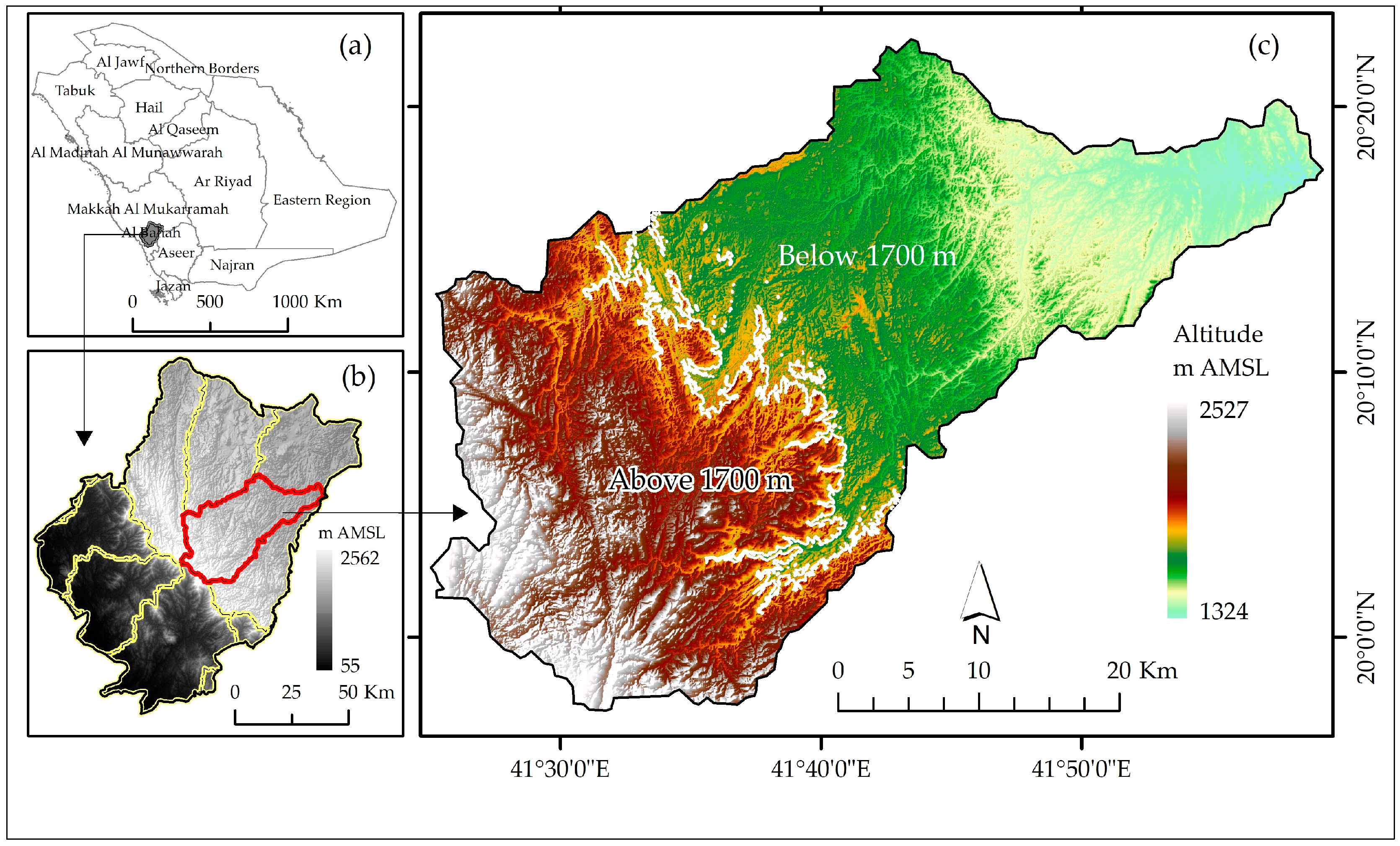

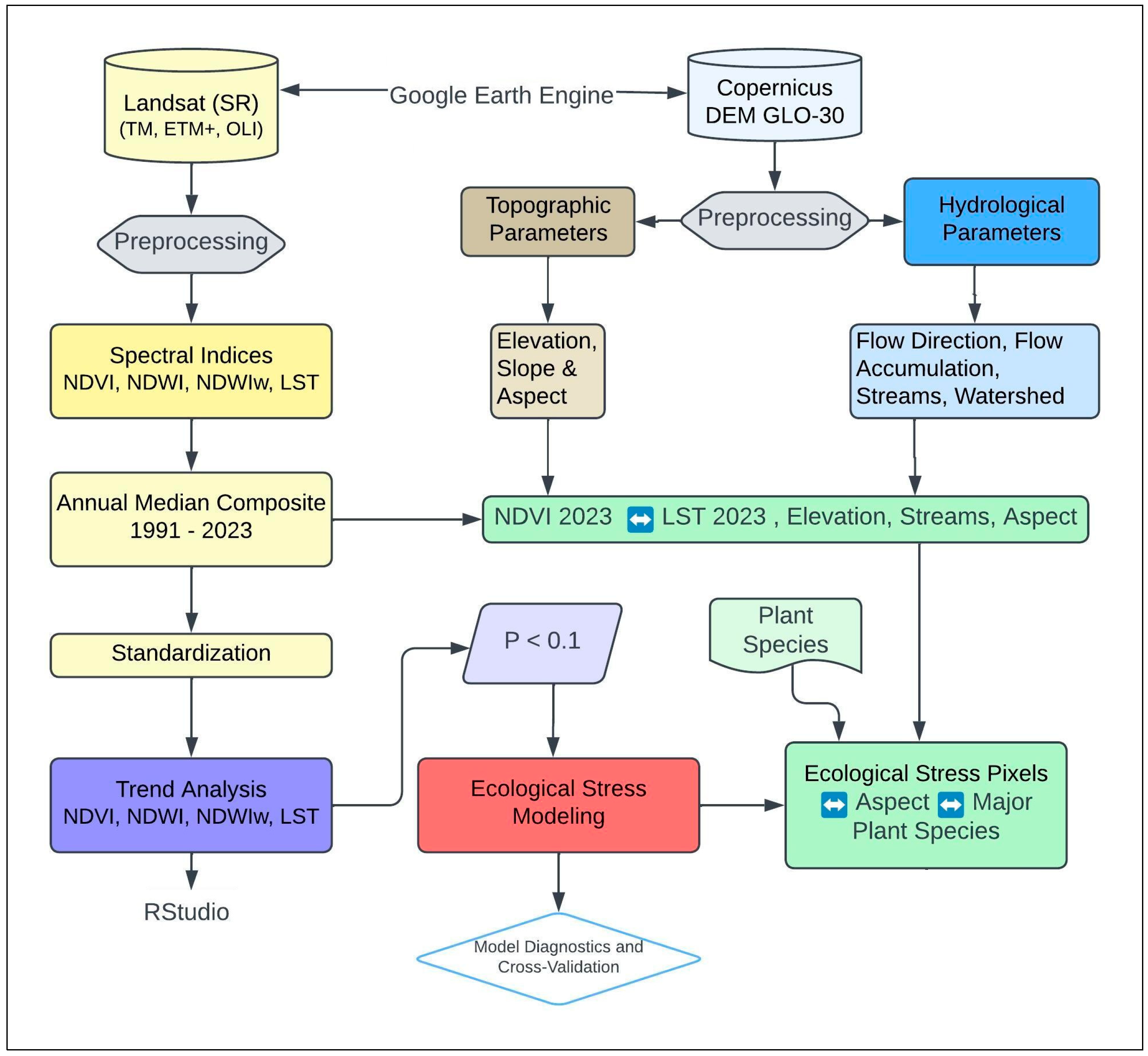
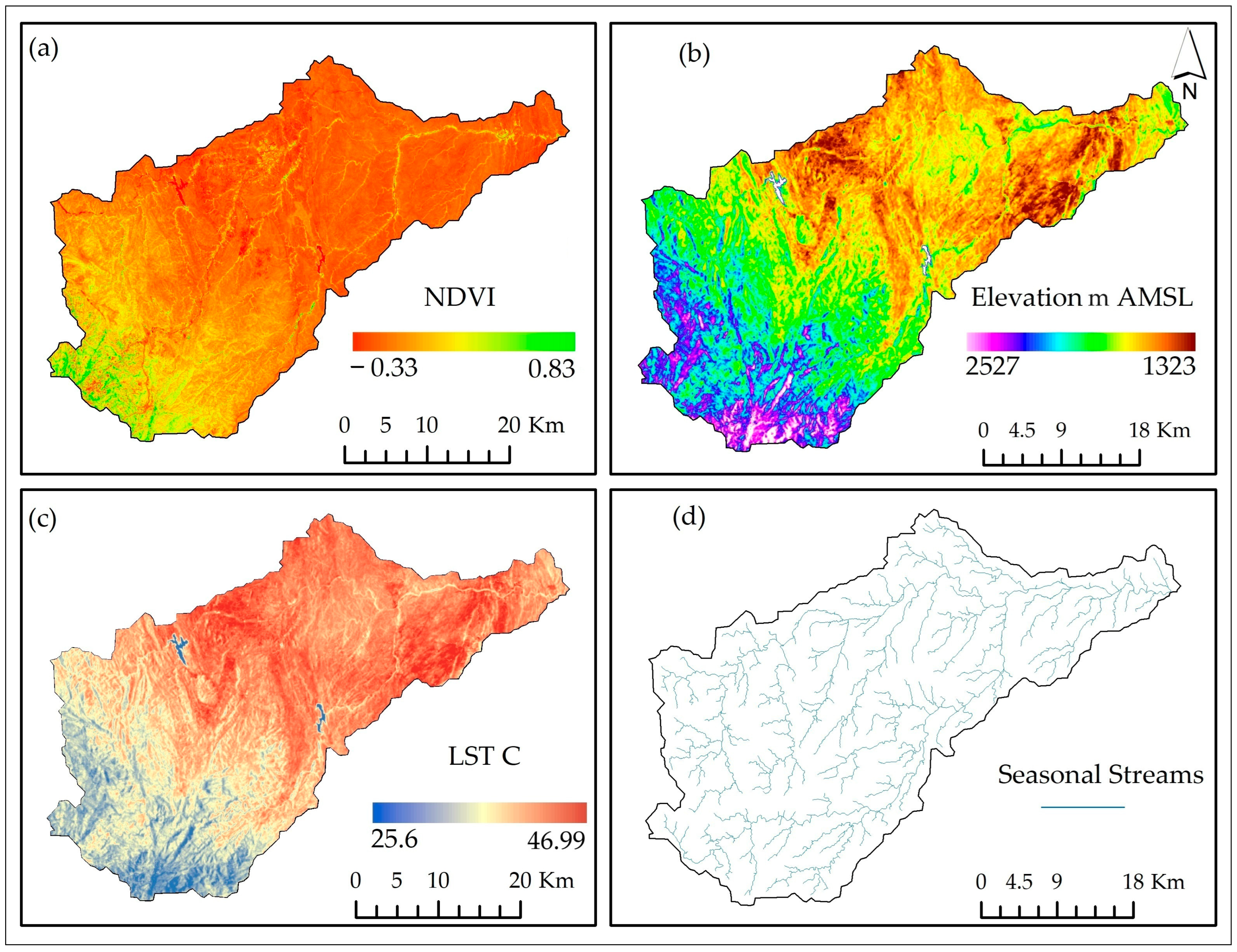


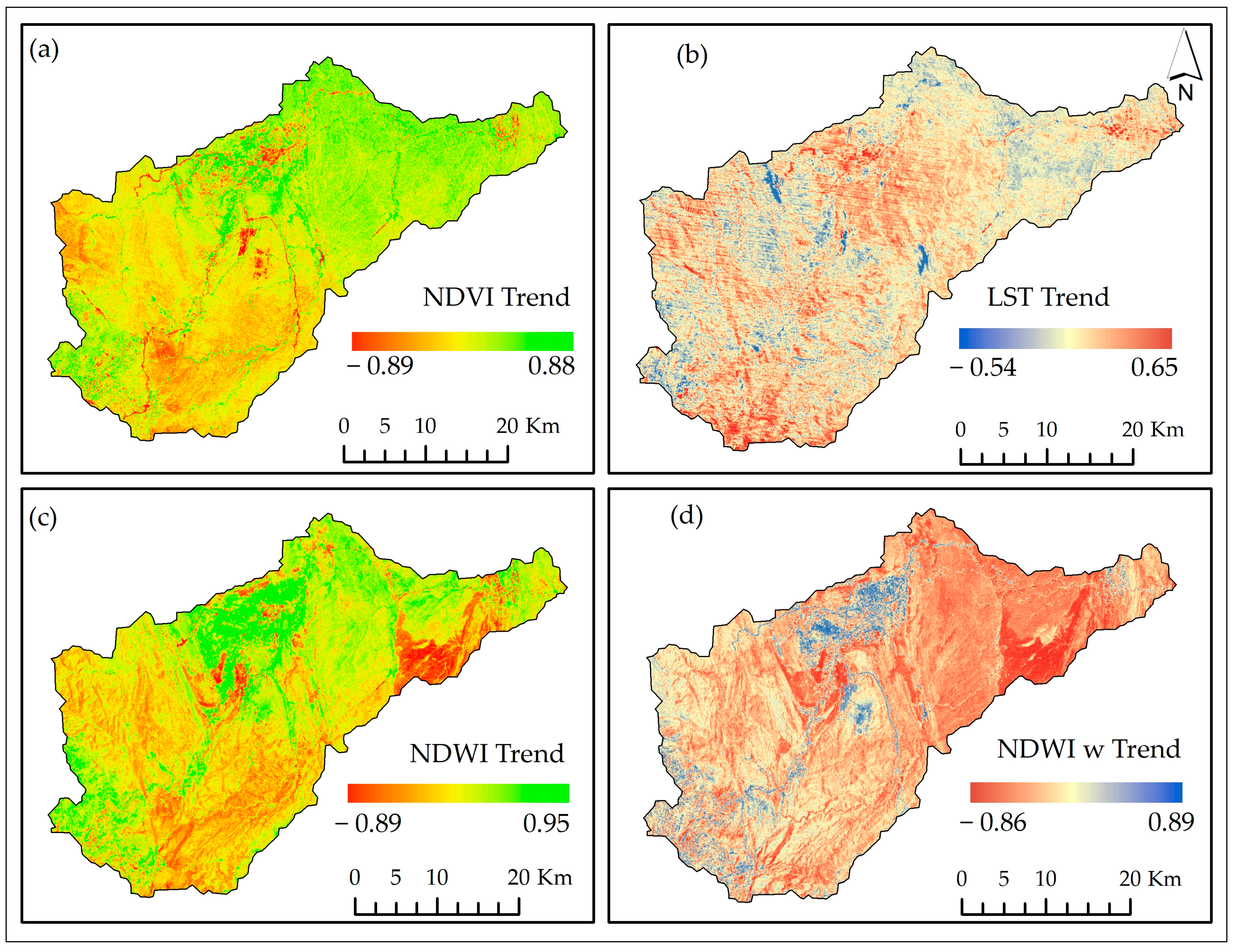



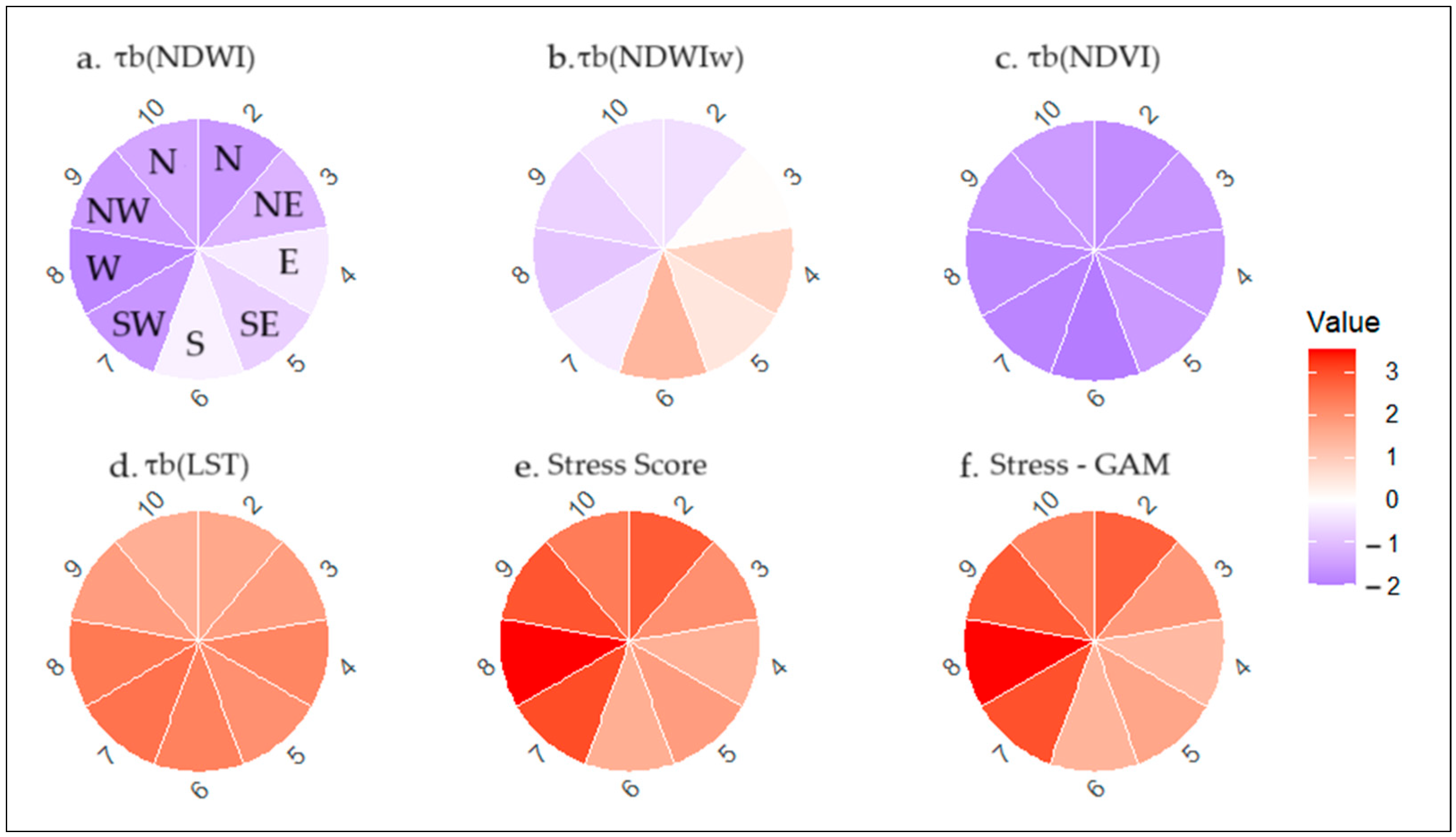
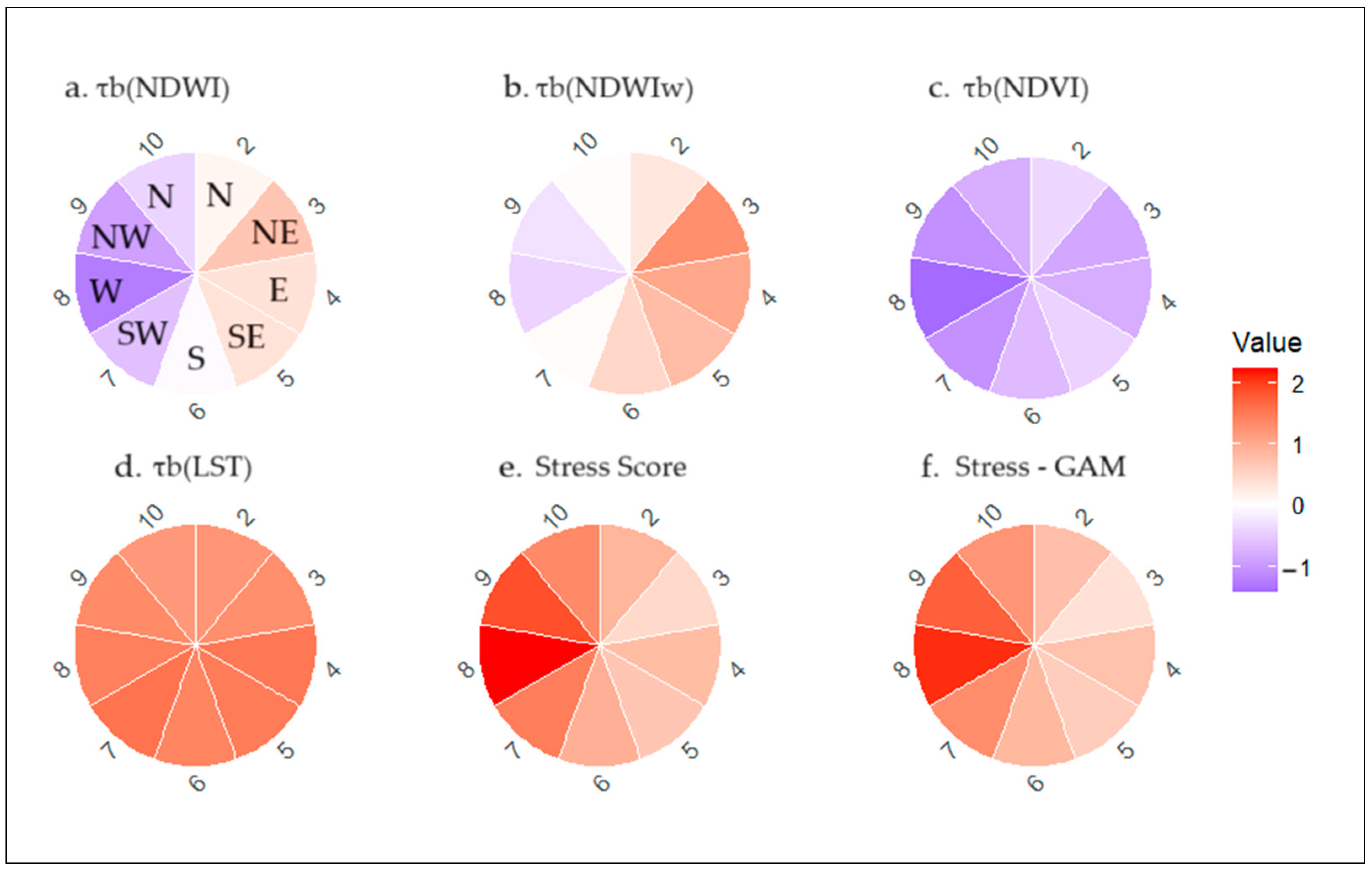
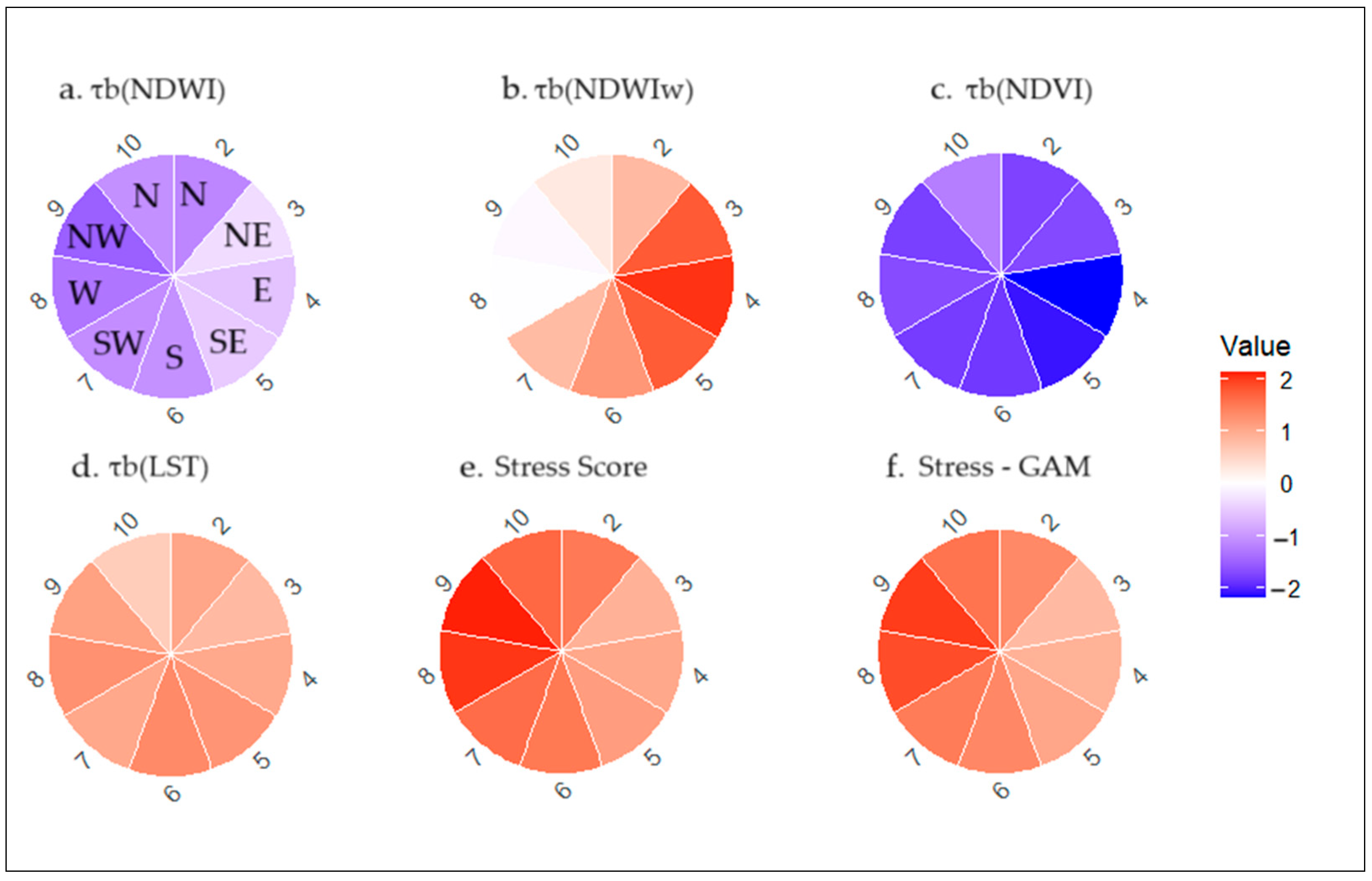
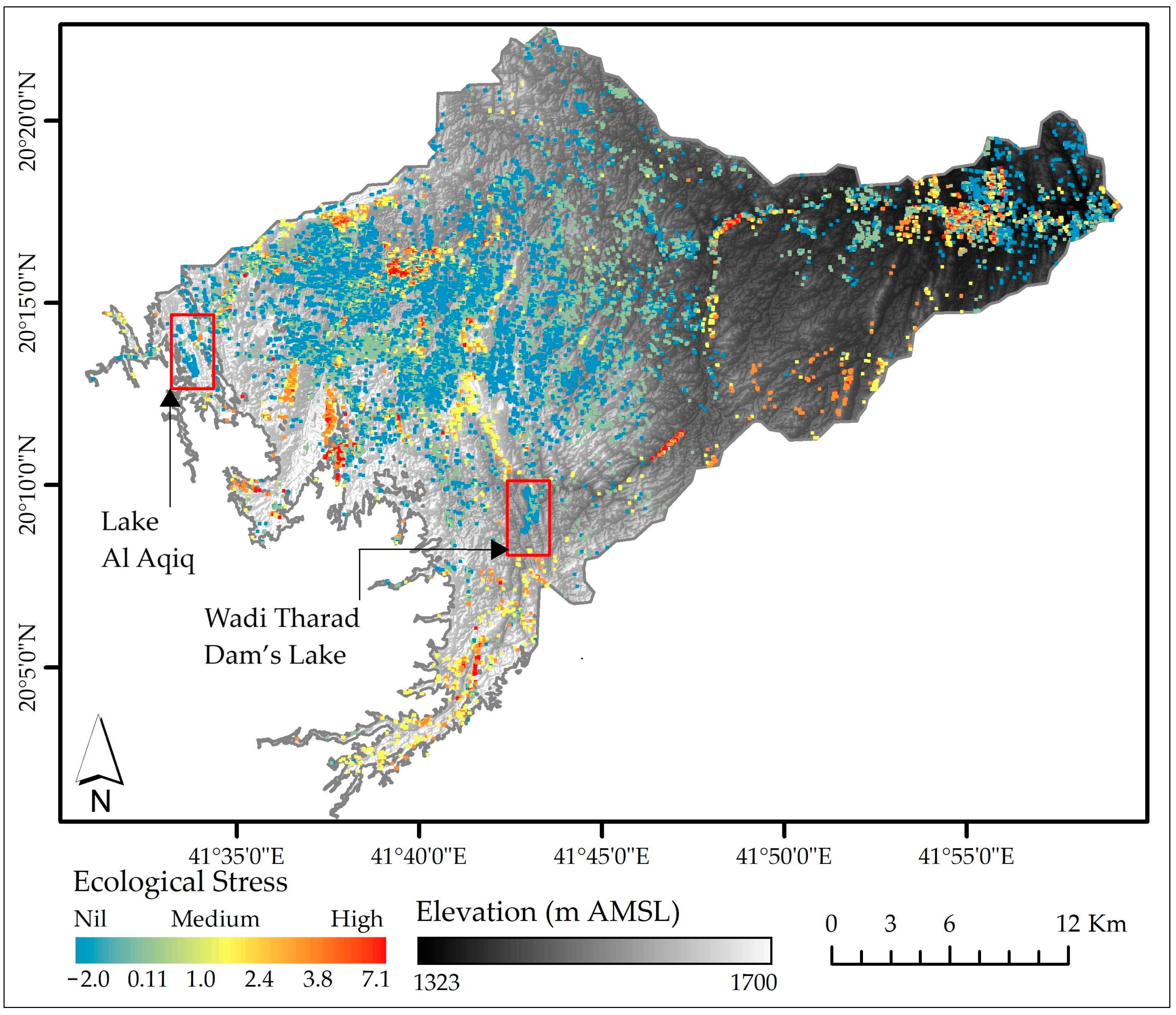

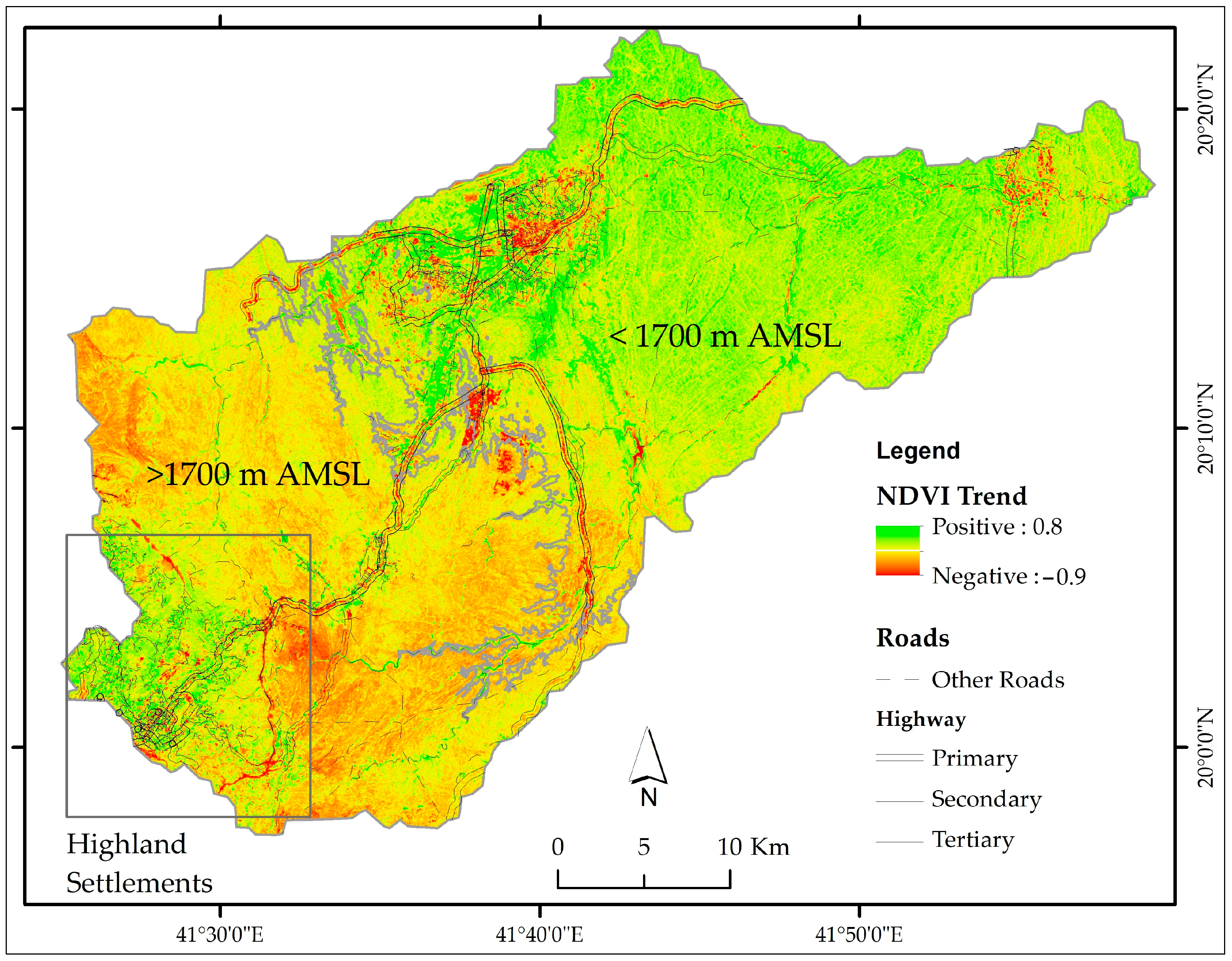
| Sensor | Green (µm) | Red (µm) | NIR (µm) | SWIR1 (µm) | SWIR2 (µm) | Thermal (µm) |
|---|---|---|---|---|---|---|
| Landsat 5 TM | B2 (0.52–0.60) | B3 (0.63–0.69) | B4 (0.76–0.90) | B5 (1.55–1.75) | B7 (2.08–2.35) | B6 (10.40–12.50) |
| Landsat 7 ETM+ | B2 (0.52–0.60) | B3 (0.63–0.69) | B4 (0.77–0.90) | B5 (1.55–1.75) | B7 (2.09–2.35) | B6 (10.40–12.50) |
| Landsat 8 OLI | B3 (0.53–0.59) | B4 (0.64–0.67) | B5 (0.85–0.88) | B6 (1.57–1.65) | B7 (2.11–2.29) | TIRS B10 (10.60–11.19) |
| Aspect | Median NDVI During 2023 | Total Area km2 | |||||||
|---|---|---|---|---|---|---|---|---|---|
| <0 | 0–0.05 | 0.05–0.1 | 0.1–0.15 | 0.15–0.2 | 0.2–0.25 | 0.25–0.3 | >0.3 | ||
| Flat | 1.92 | 0.02 | 0.01 | 0.01 | 0.00 | 0.00 | 0.00 | 0.00 | 1.97 |
| N | 0.05 | 0.44 | 27.42 | 30.56 | 16.81 | 8.98 | 3.69 | 3.24 | 91.19 |
| NE | 0.19 | 1.08 | 68.70 | 73.27 | 35.56 | 16.53 | 6.50 | 5.65 | 207.48 |
| E | 0.15 | 1.50 | 79.98 | 83.76 | 35.05 | 15.17 | 5.69 | 6.24 | 227.53 |
| SE | 0.10 | 1.01 | 61.79 | 67.87 | 29.36 | 13.62 | 5.16 | 5.22 | 184.14 |
| S | 0.08 | 0.69 | 48.19 | 54.83 | 25.62 | 11.52 | 4.32 | 4.04 | 149.28 |
| SW | 0.21 | 0.74 | 48.45 | 50.75 | 24.13 | 10.73 | 4.16 | 4.34 | 143.50 |
| W | 0.16 | 0.70 | 55.22 | 55.14 | 26.97 | 14.07 | 7.15 | 7.30 | 166.72 |
| NW | 0.12 | 0.66 | 50.55 | 54.01 | 27.86 | 15.82 | 8.87 | 8.96 | 166.86 |
| N | 0.04 | 0.38 | 25.47 | 28.40 | 15.19 | 8.48 | 4.03 | 3.85 | 85.84 |
| Total area km2 | 3.01 | 7.23 | 465.79 | 498.59 | 236.56 | 114.92 | 49.57 | 48.84 | 1424.52 |
| Indices | p < 0.05 (Above 95% CL) | p = 0.05–0.10 (90% < CL ≤ 95%) | ||
|---|---|---|---|---|
| (−) Trend | (+) Trend | (−) Trend | (+) Trend | |
| NDVI | 91.66 | 184.71 | 37.28 | 77.94 |
| LST | 1.54 | 116.15 | 0.39 | 217.74 |
| NDWI | 138.51 | 456.97 | 36.47 | 72.20 |
| NDWIw | 804.92 | 93.51 | 88.33 | 11.54 |
Disclaimer/Publisher’s Note: The statements, opinions and data contained in all publications are solely those of the individual author(s) and contributor(s) and not of MDPI and/or the editor(s). MDPI and/or the editor(s) disclaim responsibility for any injury to people or property resulting from any ideas, methods, instructions or products referred to in the content. |
© 2025 by the authors. Licensee MDPI, Basel, Switzerland. This article is an open access article distributed under the terms and conditions of the Creative Commons Attribution (CC BY) license (https://creativecommons.org/licenses/by/4.0/).
Share and Cite
Al-Huqail, A.A.; Islam, Z. Ecological Stress Assessment on Vegetation in the Al-Baha Highlands, Saudi Arabia (1991–2023). Sustainability 2025, 17, 2854. https://doi.org/10.3390/su17072854
Al-Huqail AA, Islam Z. Ecological Stress Assessment on Vegetation in the Al-Baha Highlands, Saudi Arabia (1991–2023). Sustainability. 2025; 17(7):2854. https://doi.org/10.3390/su17072854
Chicago/Turabian StyleAl-Huqail, Asma A., and Zubairul Islam. 2025. "Ecological Stress Assessment on Vegetation in the Al-Baha Highlands, Saudi Arabia (1991–2023)" Sustainability 17, no. 7: 2854. https://doi.org/10.3390/su17072854
APA StyleAl-Huqail, A. A., & Islam, Z. (2025). Ecological Stress Assessment on Vegetation in the Al-Baha Highlands, Saudi Arabia (1991–2023). Sustainability, 17(7), 2854. https://doi.org/10.3390/su17072854






